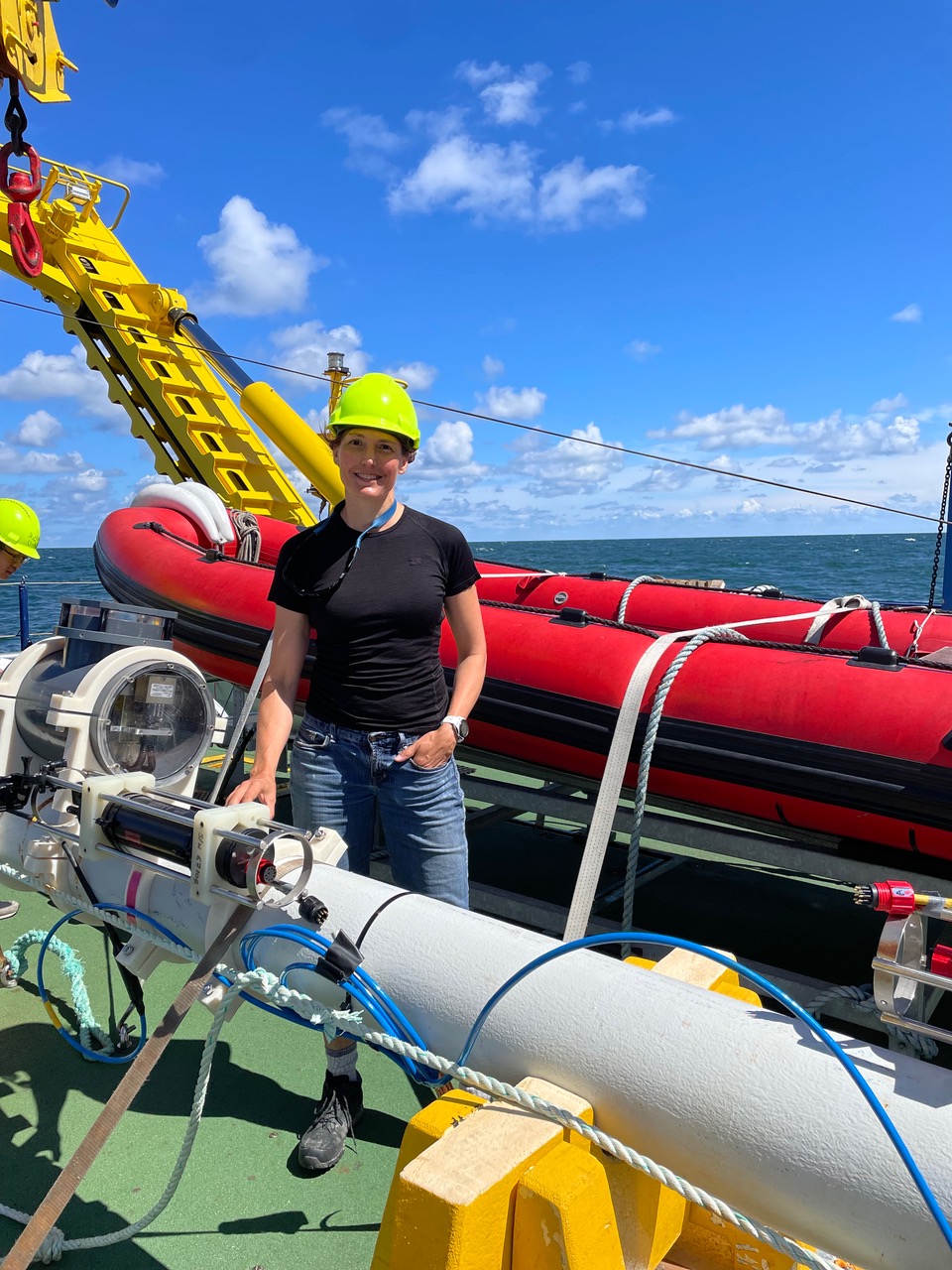By Helen Czerski
***deutsche Version siehe weiter unten***
07.07.2022
One of the privileges of living at sea is that you live inside the rhythm of the ocean, rolling with the ship as the restless water shifts beneath you. Our metal home is part of the boundary between the atmosphere and the ocean, and the movement is a constant reminder that this boundary is dynamic. It’s not just that the surface changes shape as waves roll past, but also that it can shatter and reform when waves break to form thousands of small bubbles. These bubbles are temporary, but together they add significant surface area, in addition to the turbulence generated by the breaking process. The reason that we’re here is to understand how gases cross the complex air-sea boundary, and the bubbles are part of that process.
Today we deployed a bubble measurement buoy, so that we can get some idea of how many bubbles are being formed. Measuring ocean bubbles accurately is difficult – the big ones at the surface only last for a few seconds, and the ones that move further downward are very small. It’s hard to be in the best place – right at the ocean surface – without the risk of creating your own bubbles as waves slap against a buoy. Here, we’re using a specialised bubble camera that was built specifically for this job, along with some dissolved gas sensors to find out how oxygen is moving around in the top few metres of the sea. In the first test, we also had a hydrophone, to listen to new bubbles being formed. But the hydrophone stopped working after the test deployment (there’s always a sacrifice at sea!), so the data we’ll get back will be pictures only, without any sound. These instruments are all in the water now, drifting with the waves, and the electronics are in control for the next three days. After that, we’ll bring it back on board to download data and replace the batteries.
Everyone is relieved that the major parts of the experiments have now started properly. It’s been a tough start to the cruise – lots of us had problems with different scientific instruments, and it seemed as though everything was a bit of a struggle. But most of the problem have now been sorted out, and from now on we will have a much more regular schedule. Best of all (for those of us interested in bubbles), the wind will pick up tomorrow, so there will hopefully be plenty of bubbles to measure.
Einer der Vorzüge auf See ist, dass man im Rhythmus des Ozeans lebt, mit den Schiffsbewegungen mitgeht, während sich das unruhige Wasser unter einem bewegt. Unser “zu Hause aus Stahl” ist Teil der Grenze zwischen Atmosphäre und Ozean, und die Bewegung erinnert uns ständig daran, dass diese Grenze dynamisch ist. Die Oberfläche verändert nicht nur ihre Form, wenn Wellen vorbeiziehen. Die Oberfläche kann auch zerbrechen und sich neu bilden, wenn Wellen brechen und sich Tausende von kleinen Blasen bilden. Diese Bläschen sind zwar nur von kurzer Dauer, aber zusammengenommen vergrößern sie die Oberfläche erheblich und erzeugen zusätzliche Turbulenzen, die durch den Brechungsprozess entstehen. Wir sind hier um zu verstehen, wie Gase die komplexe Luft-Meer-Grenze überwinden – und die Blasen sind ein Teil dieses Prozesses.
Heute haben wir dazu eine Boje zur Messung der Blasenbildung ausgesetzt. Die genaue Messung von Blasen im Meer ist schwierig – die großen Blasen an der Oberfläche bestehen nur wenige Sekunden, und die Blasen, die sich weiter nach unten bewegen, sind sehr klein. Es ist daher schwierig, sich am idealen Ort aufzuhalten ohne das Risiko einzugehen, direkt an der Meeresoberfläche selbst Blasen zu erzeugen, wenn die Wellen gegen eine Boje klatschen. Wir verwenden daher eine spezielle Blasenkamera, die eigens für diese Aufgabe gebaut wurde, zusammen mit einigen Sensoren für gelöste Gase, um herauszufinden, wie sich der Sauerstoff in den oberen Metern des Meeres verteilt. Beim ersten Test hatten wir auch ein Hydrophon, um zu hören, ob sich neue Blasen bilden. Aber das Hydrophon funktionierte nach dem Testeinsatz nicht mehr (auf See gibt es immer ein paar Verluste!), so dass wir nur Bilder ohne Ton erhalten werden. Diese Instrumente befinden sich jetzt alle im Wasser und treiben mit den Wellen, und die Elektronik gibt für die nächsten drei Tage den Takt an. Danach werden wir sie zurück an Bord bringen, um Daten herunterzuladen und die Batterien zu erneuern.
Alle sind erleichtert, dass der Hauptteil der Experimente nun richtig begonnen hat. Es war ein schwieriger Beginn der Reise – viele von uns hatten Probleme mit verschiedenen wissenschaftlichen Instrumenten, und es schien, als ob alles ein wenig mühsamer wäre. Aber die meisten Probleme sind jetzt behoben, und von nun an werden wir einen viel regelmäßigeren Zeitplan haben. Das Beste von allem ist, dass der Wind morgen auffrischen soll, so dass es hoffentlich viele Blasen zum Messen gibt.
Translation by Bita Sabbaghzadeh (IOW), Josefine Karnatz (GEOMAR)
